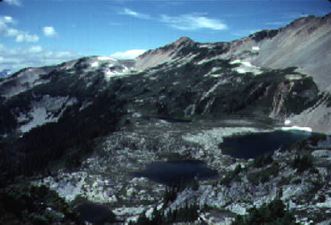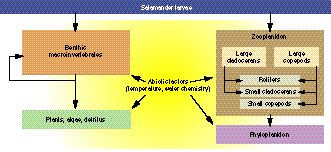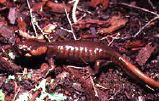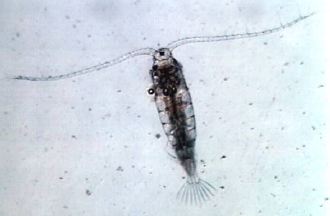Complex Interactions of Introduced Trout and Native Biota in High-Elevation Lakes
Mountain lakes in the West often occur in remote and pristine environments (Fig. 1); nevertheless, they are subject to human-induced disturbances, including global climate change, acid precipitation, ultraviolet radiation, and nonindigenous species. Most mountain lakes in the Pacific Northwest were formed by glacial activity thousands of years ago and do not naturally contain fish. Many, however, are now stocked with trout to provide opportunities for recreational fishing (Bahls 1992). Introduced trout and other nonindigenous fishes may selectively feed upon larger, more visible and active prey (Zaret 1990), and thereby adversely affect the stability of native prey populations. Negative effects include reduced densities, extirpated populations, reduced long-term regional persistence of species, and shifts in community structure toward smaller species. Such effects have been documented for amphibians (Taylor 1983; Bradford 1989; Bradford et al. 1993; Liss et al. 1995) and crustacean zooplankton (Anderson 1971, 1972, 1980; Stoddard 1987; Liss et al. 1995). Zooplankton, in particular, are important ecological components of the pelagic zone of mountain lakes. Recent research in the North Cascades National Park Service Complex in Washington suggests that the effects of trout on native biota may not be uniform on different prey species or in different lakes (Liss et al. 1995).

Fig. 1. Tapto Lakes, typical high-elevation lakes in the Cascade Mountains of Washington. Courtesy North Cascades National Park, National Park Service
Salamander larvae are the top vertebrate predator in many North Cascades National Park Service Complex lakes without fishes (Fig. 2). The long-toed salamander is the most common amphibian in high-elevation North Cascade National Park Service Complex lakes. Larvae of the long-toed salamander, which are most abundant in smaller lakes and ponds, seem highly vulnerable to predation by cutthroat trout and rainbow trout (Liss et al. 1995). Snorkeling surveys during the day and at night revealed very few long-toed salamander larvae in lakes with reproducing trout populations. In contrast, larvae of the northwestern salamander (Fig. 3) seem less vulnerable to trout predation; embryo masses and larvae are often abundant in lakes with fish. The northwestern salamander has apparently developed behavioral and morphological adaptations, which may include skin secretions noxious to predators as well as reclusive and nocturnal behavior, that render it more capable of avoiding predation by trout.

Fig. 2. Diagram of a typical food web in high-elevation lakes without fishes in the Cascade Mountains.

As in most nutrient-poor mountain lakes, North Cascades National Park Service Complex lakes generally contain few species of crustacean zooplankton. Dominance of communities by a single species is common; often one species, usually a large Diaptomus copepod (Fig. 4), makes up more than 90% of crustacean zooplankton abundance. Large copepods such as Diaptomus kenai, which is the most common species of crustacean zooplankton in this area, are apparently able to feed on a variety of foods including phytoplankton and other zooplankton. Large diaptomid copepods are probably the dominant pelagic, invertebrate predator when fish are absent, because other species of predaceous zooplankton (for example, phantom midges and cyclopoid copepods) are not common in North Cascades National Park Service Complex mountain lakes.
© K. R. McAllister, Washington Department of Fish and Wildlife
Another common species of zooplankton is the small, herbivorous copepod, Diaptomus tyrrelli. Whereas D. kenai occurs in lakes with a wide range of physical and chemical characteristics, D. tyrrelli seems to prefer smaller, shallower (maximum depth 10 meters) lakes with slightly higher nutrient levels (Liss et al. 1995). Apparently, predation by D. kenai adults eliminates D. tyrrelli from many lakes. Large copepods either do not occur or are uncommon in shallow lakes where the density of reproducing trout is high, whereas small copepods are abundant in these lakes. In contrast, large copepods are often abundant but small copepods are uncommon in lakes where the density of fishes is low.

Fig. 4. Large copepods (genus Diaptomus [this specimen is about 1.4 millimeters long]) are the dominant pelagic predator in many high Cascade lakes that lack fishes. © R. E. Truitt, Oregon State University
The effects of introduced trout in North Cascades National Park Service Complex lakes may depend on the size distribution and density of trout, the native prey species present, lake nutrient levels, and the physical characteristics of the lake basin (Liss et al. 1995). The greatest effect of introduced trout may occur when reproducing trout occur at high densities in small, shallow lakes. Many of these lakes are productive for long-toed salamander larvae, and trout seem able to reduce or eliminate larval salamanders and large diaptomid copepods in such lakes. In lakes with higher levels of nutrients, reduced densities of large copepods brought about by fish predation may allow the abundance of smaller copepods to increase. Effects of trout on native biota may be more difficult to detect in larger, deeper lakes with low densities of fish.
Oregon State University
Department of Fish and Wildlife
Nash Hall
Corvallis, Oregon 97331
Gary L. Larson
U.S. Geological Survey
Biological Resources Division
Forest and Rangeland and
Ecosystem Science Center
3200 S.W. Jefferson Way
Corvallis, Oregon 97331
References